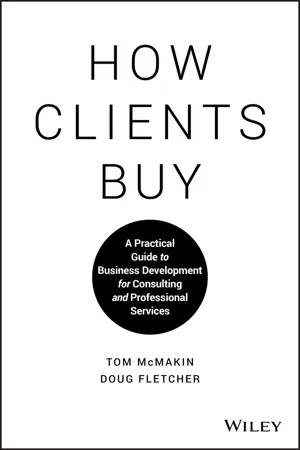
How Clients Buy
A Practical Guide to Business Development for Consulting and Professional Services
- English
- ePUB (mobile friendly)
- Available on iOS & Android
How Clients Buy
A Practical Guide to Business Development for Consulting and Professional Services
About this book
The real-world guide to selling your services and bringing in business
How Clients Buy is the much-needed guide to selling your services. If you're one of the millions of people whose skills are the 'product, ' you know that you cannot be successful unless you bring in clients. The problem is, you're trained to do your job—not sell it. No matter how great you may be at your actual role, you likely feel a bit lost, hesitant, or 'behind' when it comes to courting clients, an unfamiliar territory where you're never quite sure of the line between under- and over-selling. This book comes to the rescue with real, practical advice for selling what you do. You'll have to unlearn everything you know about sales, but then you'll learn new skills that will help you make connections, develop rapport, create interest, earn trust, and turn prospects into clients.
Business development is critical to your personal success, and your skills in this area will dictate the course of your career. This invaluable guide gives you a set of real-world best practices that can help you become the rainmaker you want to be.
- Get the word out and make productive connections
- Drop the fear of self-promotion and advertise your accomplishments
- Earn potential clients' trust to build a lasting relationship
- Scrap the sales pitch in favor of honesty, positivity, and value
Working in the consulting and professional services fields comes with difficulties not encountered by those who sell tangible products. Services are often under-valued, and become among the first things to go when budgets get tight. It is now harder than ever to sell professional services, so your game must be on-point if you hope to out-compete the field. How Clients Buy shows you how to level up and start winning the client list of your dreams.
Frequently asked questions
- Essential is ideal for learners and professionals who enjoy exploring a wide range of subjects. Access the Essential Library with 800,000+ trusted titles and best-sellers across business, personal growth, and the humanities. Includes unlimited reading time and Standard Read Aloud voice.
- Complete: Perfect for advanced learners and researchers needing full, unrestricted access. Unlock 1.4M+ books across hundreds of subjects, including academic and specialized titles. The Complete Plan also includes advanced features like Premium Read Aloud and Research Assistant.
Please note we cannot support devices running on iOS 13 and Android 7 or earlier. Learn more about using the app.
Information
How Clients Buy
Chapter 8
The Secret to Selling
Never Say Sell
I actually don't think you can sell professional services. I think you have to help clients buy them. Clients have problems and they need help in discovering, understanding and tackling them. Once people realize you helped them solve problems, then they will come back.—Walt Shill, formerly of McKinsey and Accenture
Pete,Meet Mac Shields. Mac attended your presentation recently and wanted to see if you would be interested in meeting up for coffee.Mac is an old friend, a business associate and a smart guy. He has done great work for me in developing our go-to-market business strategy.I'll let you guys take it from here!SylviaSent from my iPhone
----Original Message-----From: Peter Tyre [mailto: [email protected]]Sent: Thursday, May 21, 2015 10:52 AMTo: Sylvia Senaldi; Mac ShieldsSubject: Re: IntroThanks for the intro, Sylvia.Mac, I'd love to meet up with you. I'm traveling until next Tuesday.Do you have time next week before Friday?Best regards,PeteDr. Peter TyreChief Executive OfficerPeak Photonics, Inc.
-----Original Message-----From: Mac Shields [mailto: [email protected]]Sent: Thursday, May 21, 2015 11:11 AMTo: Peter Tyre; Sylvia SenaldiSubject: Re: IntroYes, thanks for the introduction, Sylvia. Moving you to bcc:Hi, Pete:I enjoyed hearing you speak at the B2B Luncheon on Monday and learning a bit about Peak Photonics. I had no idea there was such a cluster of photonics companies based here in Austin. I knew there were a few, but nothing to the level that exists today.I'd like to take you to coffee, introduce myself and learn a bit more about Peak Photonics. Or, if it's more convenient to meet at your office, just let me know. How would next Thursday at 8:30 am work for you?Thanks,Mac ShieldsFounder, Shields Associates, LLC.www.linkedin.com/in/macshieldswww.shieldsassociates.net
Never Say Sell
[He] worked hard at building the firm's reputation throughout his time at McKinsey. In 1939, he wrote several articles addressing organizational and financial issues with which U.S. companies were struggling at the time. He also made a dozen speeches at professional organizations, played countless rounds of golf with prospective clients, lunched with executives at every opportunity, and encouraged everyone at McKinsey to do the same.
Design Thinking Meets Business Development
Design Thinking is a design methodology that provides a solution-based approach to solving problems. It's extremely useful in tackling complex problems that are ill-defined or unknown by understanding the human needs involved and re-framing the problem in human-centric ways.—Rikki Dam, cofounder, IDF
There's a shift under way in large organizations, one that puts design much closer to the center of the enterprise. But the shift isn't about aesthetics. It's about applying the principles of design to the way people work.
Table of contents
- Cover
- Title Page
- Copyright
- Dedication
- The Problem
- Obstacles
- How Clients Buy
- Putting the Seven Elements to Work
- Notes and References
- Acknowledgments
- About the Authors
- Index
- End User License Agreement